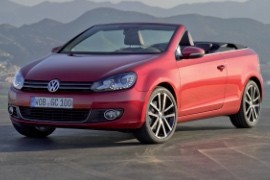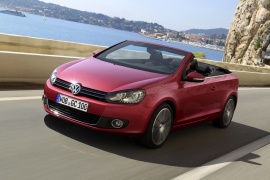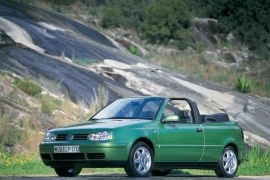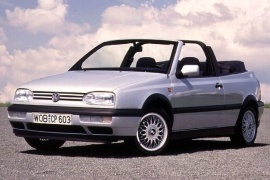VOLKSWAGEN Golf Cabrio Models/Series Timeline, Specifications & Photos
First production year: 1993
Engines: Gasoline, Diesel
Body style: Convertible (spider/spyder, cabrio/cabriolet, drop/open/soft top)
Volkswagen had already introduced the seventh generation of the Golf in 2012. However, it still kept the open-top version of the sixth generation on the assembly line but enhanced it in 2015.
While all the European automakers had already introduced their Euro 6 versions or new models. Instead, Volkswagen cut costs and used the same bodywork from the Golf's sixth generation convertible, updated with new engines.
There were not any new signs on the car's exterior. It featured the same headlights as its predecessor, with integrated LEDs for daytime running lights. Volkswagen bragged about the car's ragtop as the best-insulated one on the market thanks to the triple layer system. The upper one was air-tight and didn't allow the wind to fill the fabric roof with air. In addition, the roof could have been raised or lowered at speeds of up to 30 kph (19 mph). When retracted, the car didn't sport any B-pillar or other visible roll-over protections.
With its cabin fit for four adults, the Golf Cabriolet was a darling for many customers. But, as usual in this segment, the front passengers were spoiled with plenty of room, while the rear bench didn't provide enough legroom for average-sized customers. That happened because the back seats were pushed forward to leave some room for the folded roof behind them.
Under the hood, Volkswagen installed a new range of refreshed engines ranging between a modest 125 PS (123 HP) and 270 PS (266 HP), the latter being for the R-version.
After nine years of absence on the market, the cabriolet version of the Golf rejoined the Volkswagen family with its retractable ragtop and completed the lineup of the German carmaker’s compact vehicle.
Volkswagen thought that by launching the Eos in 2006 with a retractable hard top, it didn’t need a regular, canvas-roof convertible. Still, customers soon realized that the Eos was not a true Golf Cabrio, at least not in terms of styling or feeling, so they asked for a regular open-top version of the beloved German hatchback. As a result, in 2011, at the Geneva Motor Show, the automaker introduced the cabriolet for the Golf Mk6, which lasted until 2016, and it didn’t have a successor since the Golf Mk7 didn’t have an open-top version.
The convertible version of the Golf VI had the same chassis as the Eos but shared some body panels with the regular three-door hatchback version. Its front fascia, for instance, featured the distinct-looking headlights of the Golf with their organic, rounded shapes and integrated daytime running lights. The simple grille sported just two horizontal slats and supported the brand’s logo in the middle, while on the lower bumper, the automaker installed a second grille that cooled the engine and the side-mounted fog lamps in individual clusters.
From its profile, the thick A-pillars also served as roll-over protection systems, and there were no B- or C-pillars behind. A retractable one was fitted, though, which deployed in case of emergency. The retractable canvas top was made with four bows and could be completely retracted behind the rear seats in a dedicated compartment in 9 seconds. Closing the vehicle took two seconds longer, and both operations could be performed at the touch of a button at speeds of up to 30 kph (19 mph). The hydraulically operated mechanism was considered more reliable than an electric-only one, even though that added some mass to the vehicle. Finally, at the back, the automaker installed LED taillights, carried over from the Golf GTI.
Inside, the front bucket seats were available with or without high-bolstered areas and were separated by a narrow center console that housed the gear stick. The dashboard and the instrument cluster were identical to those installed on the rest of the Golf range. In the back, the automaker installed two individual seats and a load-through folding-down panel that could extend the trunk area. Volkswagen had to move the bench seat forward to make room for the retractable canvas roof behind the cabin, and, as a result, legroom for those seated in the back was limited.
Volkswagen dared to provide the Golf VI Cabriolet with a wide choice of engines, including its newly developed turbo-diesel versions, despite the Dieselgate scandal. A five- or six-speed manual was fitted as standard for most versions, while the top-of-the-range TSI powerplant was available exclusively with a seven-speed automatic (dual-clutch) transmission.
Volkswagen offered an open-top version for the Golf IV range, but there was a trick; it was actually a Golf III with Golf IV headlights.
The German carmaker introduced the Golf IV in August 1997 as a 3- and 5-door hatchback. In 1998, it introduced the station-wagon. But something was missing: the convertible. There was no gain in building a new vehicle from some points of view, so VW decided to do a trick: it took the Golf III Cabriolet and transformed it into a Golf IV Cabriolet. Something like having a non-facelifted model and changing the bumpers and headlights to look like the facelifted version.
Its headlights were clearly carried-over from the MK IV version, with four lamps inside each headlight. Most of the front body panels were taken or adapted to the new look. But, viewed from its sides, the car revealed its true origins, the MK III version. A thick B-pillar was planted behind the doors, with a safety-arch crossing the car from left to right side. In the back, the canvas-top was exposed behind the rear bench when it was folded.
Inside, the carmaker installed exactly the same dashboard as in the Golf III range, with a driver-oriented center stack. The Golf IV Cabriolet offered just cranked windows, no AC, and no stereo on the entry-level. The upper trim levels featured power-windows, a good sound system, and automatic transmission.
Under the hood, Volkswagen installed some of the engines which were available on the Golf III. With a choice of gasoline and diesel units, the Golf IV Cabriolet was an appealing vehicle in its class.
Volkswagen Golf convertible was a long-awaited model for the German brand fans.
Two decades after the Golf's first generation was introduced to the market, Volkswagen introduced the second generation of the convertible version, which was absent from the Golf II lineup. Some said that the wait was totally worth it since the Golf II was considered only an enhanced version of the first generation.
The Golf III Cabrio shared the same front side as the hatchback version. Due to its rounded, but not round, headlights, and curved edges, the third generation of the famous compact-segment Volkswagen was completely different than its predecessor. A raked windshield and a safety bar in the middle of the cabin made the car unmistakable on the road. The canvas top could have been removed manually and stored behind the rear seats.
Due to the driver-oriented center stack, the Golf III offered a sportier feeling than its predecessors. The dashboard was available either in one color or in a two-tone scheme that inspired a premium look. The Golf III Cabriolet offered just cranked windows, no AC, and no stereo on the entry-level. The upper trim levels featured power-windows, a good sound system, and automatic transmission.
Volkswagen installed a choice of gasoline and diesel engines. For the European market, the base version was powered by a 1.4-liter four-pot, while the top version featured a 2.0-liter unit.



